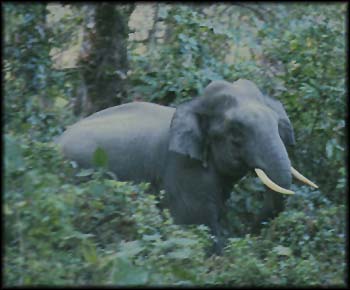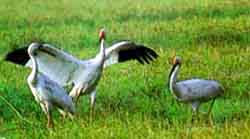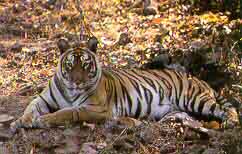| Environment Beautiful Beasts of Nagarhole
|
|||||||||||||||||
The mini bus rattled along the jungle roads through the 6.30 morning mists. We peered out of the windows, hoping to see tiger, but with the sound that the bus was making we would settle for any lesser being. What we did see were animals who were less elusive than the tiger, but certainly not lesser beings.The two biggest animals that still roam the Indian wild are the elephant and the Indian bison, known locally as gaur. Now if you want a guaranteed look at these magnificent creatures in their natural habitat, then you must visit Nagarhole. Yes, that was the jungle we were roaming in the early morning mist. In the three days we spent there on the four early morning and late evening safaris that we took, our only encounter with a tiger was spotting his fresh pug marks by the side of a stream. And we really cursed the noisy bus for we felt sure that it was the rattling metal beast that had frightened away the magnificent striped animal from the stream. |
Environment • Paradise in the Wild • The Ocean:Conquest • A Source of Solace • Sighting the Ocean • The Ocean in Verse • Childhood Dream • Hunt for Indian Tiger
Adventure activities | ||||||||||||||||
Then there was old white-socks. While one is used to tame elephants ambling about crowded streets, the gaur, with its hefty build, large horns and white shanks is a far cry from its domesticated bovine cousins: cows, bulls and buffaloes. Not a single trip within the jungle passed without our sighting these imposing animals with their gleaming, blue-black skin. Sometimes they were at a distance but at least on a couple of occasions they stopped grazing and stared at us from just a few feet away. It is no wonder that visitors are forbidden from venturing on foot into the jungles of Nagarhole. The elephants and gaur are huge and wild and we ordinary humans are no match for them in their homeland. By far the most visible animals here are the cheetal or spotted deer. These come and graze right near the forest rest houses. The other ungulates, which thrive at Nagarhole, but are shier than the cheetal, are sambhar, barking deer, and the four horned antelope. The last we did not see and in fact sightings are so rare that along with species like tigers and panthers, they qualify for an entry in the sightings book kept at the forest lodge.
Nagarhole, in Karnataka, is really only one of the four contiguous sanctuaries in South India which span the states of Kerala, Tamil Nadu and Karnataka. The other three are Bandipur (Karnataka), Mudumalai (Tamil Nadu) and Wynad (Kerala). The topography is generally the same in all these national parks: the topography of tiger country. Basically, two types of forests dominate the region: The moist deciduous type is to the north and West of Nagarhole while the dry deciduous type exists in the south and east. High quality teak and rose wood trees are found here. Bamboo is also plentiful.
But ultimately we didn't see tiger. Seeing the striped king is such a chancy affair. I have a friend who has spent a greater part of his life in jungles but has never spotted a tiger. Then finally, at Tadoba in Maharashtra, one late evening, when we had all gone looking for tigers in our jeep, this friend remained behind near the lake to gather plant species. And there he saw tiger, tigress and cubs. So the moral is, enjoy the jungle and all you see there. Bonuses, in the form of big cats will come when the jungle is ready for you.
|
|||||||||||||||||
Editor: Romola Butalia (c) India Travelogue. All rights reserved. |
|||||||||||||||||
 The elephants and gaur however, were less fazed with our vehicle. The elephants, often in herds, went about swirling the grass and leaves with their trunks before dunking sizeable morsels into their mouths. Their offspring gambolled playfully, unconcerned about prying human eyes.
The elephants and gaur however, were less fazed with our vehicle. The elephants, often in herds, went about swirling the grass and leaves with their trunks before dunking sizeable morsels into their mouths. Their offspring gambolled playfully, unconcerned about prying human eyes.
 Although we were not allowed to go birding into the jungle, we had a fine time with the birds just outside the forest lodge. Golden and black-headed orioles, drongos, racket-tailed drongos, large green barbets, spotted babblers, red-cheeked and red-vented bulbuls, crimson minivets, and hoopoes descended on the trees and ground around giving us a grand stand view of avian activity.
Although we were not allowed to go birding into the jungle, we had a fine time with the birds just outside the forest lodge. Golden and black-headed orioles, drongos, racket-tailed drongos, large green barbets, spotted babblers, red-cheeked and red-vented bulbuls, crimson minivets, and hoopoes descended on the trees and ground around giving us a grand stand view of avian activity.
 Animal safaris are in the early mornings and late evenings. If you have a vehicle you can spend an enjoyable part of the rest of the day at the Irpu waterfalls, about another 7 kms from Kutta. The Rameshwara Temple is at the base from where you have to climb for about a kilometre to reach the falls. The falls were quite impressive although it was well past the monsoon season when we went there.
Animal safaris are in the early mornings and late evenings. If you have a vehicle you can spend an enjoyable part of the rest of the day at the Irpu waterfalls, about another 7 kms from Kutta. The Rameshwara Temple is at the base from where you have to climb for about a kilometre to reach the falls. The falls were quite impressive although it was well past the monsoon season when we went there.